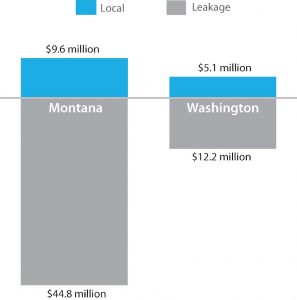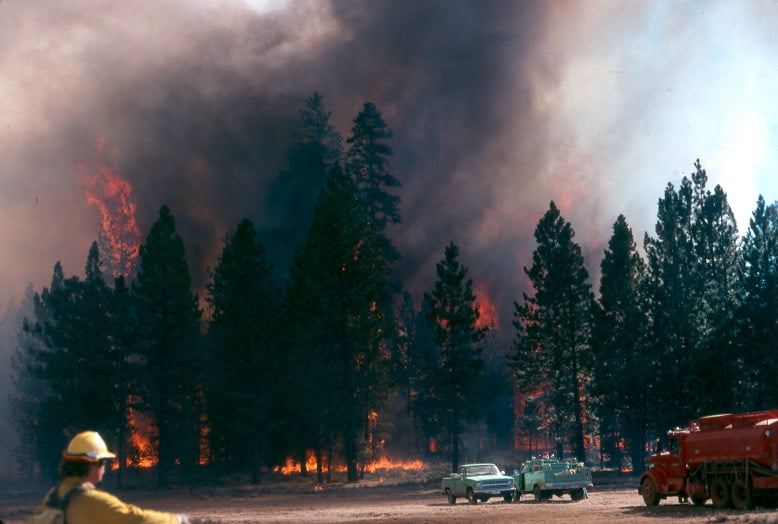There are scary and uncertain times ahead for our forests. There is just too much “Fog of War” going on for the public to sort out and fact-check for themselves. Even the ‘fact-checkers’ should be suspect, until proven reliable and bias-free. The rise of ‘fake news’ has blurred multiple lines, and many people, even in mass media, fall for the hoaxes, satire or misinformation. (Example: An article appeared on the Grist website, showing concern about a recall of “Dog Condoms”, presenting the link to www.dogcondoms.com )
Sustainable Rural Economies
Humans sparked 84 percent of US wildfires, increased fire season over two decades
How should we deal with the new math on forest fires?
If this article published in the February Proceedings of the National Academy of Sciences is not a fluke then it would seem to me that our expanding population dictates the need for more forest management not less. The less desireable alternative would be to severely restrict access to our federal forests. The main conclusion of the article is that humans sparked 84 percent of US wildfires and caused nearly half of the acreage lost to wildfire. This number excludes intentionally set controlled burns.
From the above, I would deduce that human initiated fires caused proportionally less acreage loss because they were closer to civilization and to forest access points and therefore closer to and more easily accessed by suppression resources. The fact that nearly half of the wildfire acres lost occur in these areas suggests that we would get more bang for our tax dollars if we increased and focused federal sustainable forest management around high traffic areas easily accessible to humans.
Knowing that humans who cause wildfires are, by definition, either careless or malicious, we might deduce that they are generally not inclined to put great effort into getting to their ignition set points. This would lead us to consider that human caused fires might prove to be in less difficult terrain areas with high human traffic. Fires like the Rim fire being the exception. That, if true, would suggest that forest management for risk reduction on these sites could be done at lower costs per acre than other less accessible forest acreage. Focusing forest management efforts on these high benefit to cost areas would have the biggest bang per tax dollar expended in order to lower the total cost of federal wildfire control. If my thinking is correct, this should play a large part in setting the priorities as to where we should: 1) apply controlled burns to reduce ground and other low fuels, 2) utilize commercial thinnings to reduce ladder and proximity fuels or 3) use commercial regeneration harvests to create greater variation in tree heights between stands in order to provide fire breaks for crown fires when appropriate for the site and species. The net effect would be positive for all species including endangered and threatened species. There would still be plenty of lightning caused wildfire, controlled burn hotspots/breakouts and a significantly reduced acreage of human caused fires to satisfy those who don’t mind national ashtrays. Reducing the number and size of human caused fires would also free resources to attack lightning fires earlier and harder when allowing the fire to burn was not an option.
Pertinent Quotes:
- “After analyzing two decades’ worth of U.S. government agency wildfire records spanning 1992-2012, the researchers found that human-ignited wildfires accounted for 84 percent of all wildfires, tripling the length of the average fire season and accounting for nearly half of the total acreage burned.” Italics added
- “”These findings do not discount the ongoing role of climate change, but instead suggest we should be most concerned about where it overlaps with human impact,” said Balch. “Climate change is making our fields, forests and grasslands drier and hotter for longer periods, creating a greater window of opportunity for human-related ignitions to start wildfires.”” Italics added
- “”Not all fire is bad, but humans are intentionally and unintentionally adding ignitions to the landscape in areas and seasons when natural ignitions are sparse,” … “We can’t easily control how dry fuels get, or lightning, but we do have some control over human started ignitions.””
Federal lands and transitional economies
Headwaters Economics has released this update to a report discussed at length here last year:
“Rural counties in the West with more federal lands performed better on average than their peers with less federal lands in four key economic measures.”
“This update of research from last year finds that from the early 1970s to the early 2010s, population, employment, and personal income on average all grew significantly faster—two times faster or more—in western rural counties with the highest share of federal lands compared to counties with the lowest share of federal lands. Per capita income growth was slightly higher in counties with more federal land.”
An article on “transitional communities” adds:
“Rural decline is a large and complex issue that appears to be accelerating. According to the Pew Charitable Trust, during the period between 1994–2010, 38.4 percent of U.S. rural counties lost population; since 2010, over two-thirds of rural counties lost population. This level of decline has far-reaching national and international implications for food and energy production, tourism, and national culture and identity.”
Putting them together, it looks like public lands can be an important asset for minimizing or avoiding rural decline, if communities can get their act together to embrace this potential and plan for it.
“Particularly in declining communities where long-established residents remember the charm of life in simpler times, residents can have considerable resistance to change. This connection and preservation of the past, while a rural virtue, can impede its adaptation into the future. Resistance to any proposed solution that “hasn’t been done before” simply impedes innovation or positive transition.”
Making Every Dollar Count: Leveraging Federal Investments in Land Management to Benefit Local Communities

Thanks to Chelsea McIver for providing this (investment study) about how the “benefit to local communities” consideration in the 2012 Appropriations Committee is working in practice.
Below are the conclusions..
As these two case studies demonstrate, well over half of the value of federal investments in forest restoration and maintenance activities are being lost due to leakage out of local forest communities. Along with those dollars is the lost potential for that money to circulate and “multiply” in the local economy. So what can rural forest communities do to better leverage federal investments in forest management and restoration on public lands?
New programs and authorities are in place providing an opportunity for land management agencies and communities to work together to increase the utilization of local businesses. The Collaborative Forest Landscape Restoration Program (CFLRP), established in 2009 has made job creation in local communities an explicit objective. Through 10 years of dedicated investments in restoration combined with active monitoring, the program hopes to increase the economic benefits of restoration activities accruing to local communities. Nonetheless, research by McIver (2013; 2016) and others (Moseley and Toth, 2004; Charnley et al., 2008) has shown that legislative intent alone is not enough to change the procurement contracting trends on the ground. As stated previously, government agencies need specific authorities that allow greater consideration of local contractors when awarding procurement contracts.
In 2012, Congress implemented such an authority. The fiscal year 2012 Consolidated Appropriations Act included language providing the Secretaries of Agriculture and Interior authority to consider the benefit to local communities in the awarding of contracts for forest hazardous fuels reduction and other forest and watershed restoration activities. The authority has been extended through FY17. Finally, as Abrams et al. (2015) and Pensky (1993) point out, the engagement of non-federal entities, such as community-based organizations or other non-profits, are critical for implementing import substitution programs due to their in-depth knowledge of a place, experience securing financial resources, and their ability to leverage networks to support their efforts. Careful analysis of federal contracting trends combined with local knowledge can create the foundation for a public-private effort to leveraging federal investments in forest maintenance and restoration to create wealth and build capacity in rural forest communities.
IN SEARCH OF COMMON GROUND
It seems like an exercise in futility for the “New Century of Forest Planning” group to be discussing and cussing forest planning &/ policy when we haven’t even agreed to the scientific fundamentals that serve as the cornerstone and foundation for any such discussions.
Below, I have developed a tentative outline of the high level fundamentals which any Forest Plan or Policy must incorporate in order to have a reasonable chance of meeting the desired goals. Until we can come up with a version of these “Forestry Fundamentals” that we generally agree to, we are pushing on a rope and wasting each other’s time unless our objective here is simply to snap our suspenders and vent on each other.
In your comments, please note the outline Item that you are responding to. Maybe we can revise my initial effort and come to some common ground. In doing so we would perform a service and make a step forward that would be useful outside of this circle instead of just chasing our tails. Coming to such an agreement would be a step towards developing a priority hierarchy and eliminating the internal conflicts which make current federal forest policy and law ambiguous and self-contradictory. Until we reach common ground, the current obviously unworkable policies will continue to doom our forests to poor health and consequentially increase the risk of catastrophic loss of those forests and the species that depend on them for survival.
– FORESTRY FUNDAMENTALS – 1st Draft 12/15/16
ESTABLISHED SCIENCE WHICH MUST BE INCORPORATED IN PLANNING FOR
THE SUSTAINABILITY OF FOREST DEPENDENT SPECIES
I) The Fundamental Laws of Forest Science which have been repeatedly validated over time, location, and species. They include:
— A) plant physiology dictating the impact of competition on plant health,
— B) fire science dictating the physics of ignition and spread of fire and
— C) insects and pathogens and their propensity to target based on proximity and their probability of success being inversely proportional to the health of the target.
— D) Species suitability for a specific site is based on the interaction between the following items, those listed above and others not mentioned:
— — 1) hydrology, the underlying geology and availability of nutrients in the soil.
— — 2) latitude, longitude, elevation, aspect and adjacent geography.
— — 3) weather including local &/ global pattern changes.
II) The Fundamental Laws controlling the success of endangered, threatened and other species dependent on niche forest types (ecosystems):
— A) Nesting habitat availability.
— B) Foraging habitat availability.
— C) Competition management.
— D) Sustainability depends on maintaining a fairly uniform continuum of the necessary niches which, in turn, requires a balanced mix of age classes within each forest type to avoid species extinguishing gaps.
— E) Risk of catastrophic loss must be reduced where possible in order to minimize the chance of creating species extinguishing gaps in the stages of succession.
III) The role of Economics:
— A) Growing existing markets and developing new markets in order to provide revenue to more efficiently maintain healthy forests and thence their dependent species.
— B) Wise investment in the resources necessary to accomplish the goals.
— C) Efficient allocation of existing resources.
IV) The role of Forest Management:
— A) Convert the desires/goals of the controlling parties into objectives and thence into the actionable plans necessary to achieve the desired objectives.
— B) Properly execute the plans in accordance with the intent of: governing laws/regulations and best management practices considering any economies.
— C) Acquire independent third party audits and make adjustments in management practices where dictated in order to provide continuous improvement in the means used to achieve goals.
— D) Adjust plans as required by changes: in the goals, as required by the forces of nature and as indicated by on the ground results.
— E) Use GIS software to maintain the spatial and associated temporal data necessary for Scheduling software to find and project feasible alternatives and recommend the “best” alternative to meet the goals set by the controlling parties.
What did I miss, what is wrong, what is right, what would improve this list of Forest Fundamentals?
History of logging in Montana
The Missoulian is running a series of articles on this subject. The one in Sunday’s paper asks these questions about the future:
“Banishment from the national forests would doom many Montana timber towns to welfare status, according to advocates in the wood-products industry. But if they’re dependent on access to public timber, isn’t that another form of welfare? Does my family’s tradition of working in the woods entitle it to public subsidy, especially if the commercial market finds Montana’s wood products uncompetitive? Does rescuing Montana’s timber industry justify rewriting some of the nation’s bedrock environmental protections, changing access to its court system, and spending millions of its tax dollars?”
Federal lands support diverse economies
Recent research by Headwaters Economics asked whether federal lands are an economic liability or an asset to rural communities (summarized in this opinion piece).
On average, we find that from 1970-2014, rural counties with the most federal land grew much faster than similar counties with the least federal land: population grew four times faster, employment grew three times faster and personal income grew twice as fast. Per capita income grew slightly more in places with more federal lands.
This analysis suggests that, in general, federal lands do not inhibit a community’s economic growth. On the contrary, the research suggests these lands have the potential to contribute to a prosperous rural economy.
You can always pick on the details of economic analysis, but here is what this tells me about the big picture. While there will always be winners and losers, it’s hard to argue that the presence of federal lands is a big reason for the losers.
Massive Crater Lake Wilderness Area Fantasy
Oregon Wild has proposed a massive half million acre Wilderness Area, partly to “protect” Crater Lake. The Klamath County Commissioners are saying no, with fears that summer fires would affect public health, and that those unhealthy forests need active management.
Here is a map of what Oregon Wild wants done.
Certainty and a Wilderness Bill are Good Things: Marc Brinkmeyer
 Thanks to a reader who sent this interview from Evergreen Magazine and noted that the whole series (on a banner across the top when you click the link) is interesting.
Thanks to a reader who sent this interview from Evergreen Magazine and noted that the whole series (on a banner across the top when you click the link) is interesting.
Here is a link and below is an excerpt:
“Certainty is a two-way street. We believe Idaho needs a wilderness bill for the same reasons that we need certainty in our raw material supply. There are still millions of roadless acres here in Idaho. Some of those acres belong in designated wilderness areas, some should be managed as back country and some should be allocated to active forest management with a goal of providing certainty for lumbermen, loggers and counties in which the largest landowner is the federal government. Our company will support wilderness legislation when the time is right.”
Marc Brinkmeyer, Chairman of the Board
Idaho Forest Group, Coeur d’Alene, Idaho
Is mutually assured certainty something we all can agree on?
Career Ladders for Temps?!?! Maybe Soon!
More interesting news for “disposable” employees!
 http://nffe.org/ht/display/ArticleDetails/i/105694
http://nffe.org/ht/display/ArticleDetails/i/105694
NFFE-Backed Temporary Employment Reform Legislation Approved by Senate Committee
There may come a time when temporary employees actually have a career ladder!
“Thousands of wildland firefighters and other dedicated seasonal workers have been stuck for too long in dead-end jobs, not because of a lack of merit on their parts, but because of flawed regulations that do not recognize their years of service,” said Mark Davis, Vice President of the National Federation of Federal Employees (NFFE) and past President of the NFFE Forest Service Council. “Many others leave and take their years of experience with them because of blocked career paths. After years of work, I’m optimistic that we are about to fix that.”
Of course, this is most directed towards firefighters, as so many timber temps have been jettisoned or have found “other employment”. Most temps would say that there is plenty of work to do, outside of their 1039 appointments but, that issue is not being addressed. The higher-ups choose to continue to embrace the 1039 appointments, thinking that policy is “good enough for Government work”. There really is nothing stopping the Forest Service from changing their policies on 1039 appointments. Truthfully, I’d like to see the temporary appointments scaled back to 800 hours, essentially forcing the Forest Service and other Agencies to hire more 13/13 permanent positions. Yep, make it too costly and “inconvenient” for them to continue using temps to do work that is needed, each and every year. It’s up to OPM to impose more rules, to stop the abuse of the temporary hiring authority.

